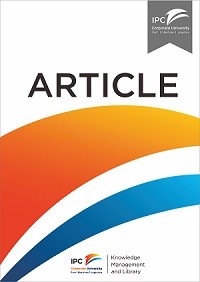Article
CO-INTEGRATION AND ERROR CORRECTION: REPRESENTATION, ESTIMATION, AND TESTING
The relationship between co-integration and error correction models, first suggested in Granger (1981), is here extended and used to develop estimation procedures, tests, and empirical examples. If each element of a vector of time series x, first achieves stationarity after differencing, but a linear combination a'x, is already stationary, the time series x, are said to be co-integrated with co-integrating vector a. There may be several such co-integrating vectors so that a becomes a matrix. Interpreting a'x, = 0 as a long run equilibrium, co-integration implies that deviations from equilibrium are stationary, with finite variance, even though the series themselves are nonstationary and have infinite variance. The paper presents a representation theorem based on Granger (1983), which connects the moving average, autoregressive, and error correction representations for co-integrated systems. A vector autoregression in differenced variables is incompatible with these representations. Estimation of these models is discussed and a simple but asymptotically efficient two-step estimator is proposed. Testing for co-integration combines the problems of unit root tests and tests with parameters unidentified under the null. Seven statistics are formulated and analyzed. The critical values of these statistics are calculated based on a Monte Carlo simulation. Using these critical values, the power properties of the tests are examined and one test procedure is recommended for application. In a veries of examples it is found that consumption and income are co-integrated, wages and prices are not, short and long interest rates are, and nominal GNP is co-integrated with M2, but not Ml, M3, or aggregate liquid assets.
Ketersediaan
Informasi Detail
- Judul Seri
-
CO-INTEGRATION AND ERROR CORRECTION
- No. Panggil
-
ATC LO ENG c
- Penerbit
- : JSTOR., 1987
- Deskripsi Fisik
-
27 p.
- Bahasa
-
English
- ISBN/ISSN
-
-
- Klasifikasi
-
LO
- Tipe Isi
-
-
- Tipe Media
-
-
- Tipe Pembawa
-
online resource
- Edisi
-
Vol. 55, No. 2 (March, 1987), 251-276
- Subjek
- Info Detail Spesifik
-
-
- Pernyataan Tanggungjawab
-
Robert F. Engle
Versi lain/terkait
| Judul | Edisi | Bahasa |
|---|---|---|
| Dynamics of Dry Bulk Freight Market: Through the Lens of a Common Stochastic Trend Model | Volume 27 Number 3 December 2011 pp. 387-404 | en |
| Revenue estimation for logistics customer service offerings | Vol. 17 No. 1, 2006 | en |
| How much would US union membership increase under a policy of non-exclusive representation? | Vol. 32 No. 1, 2010 pp. 89-98 | en |
| Constraint-based spatial representation technique for the container packing problem | 9/1 [1998] 23–33 | en |
| Fuzzy testing and selecting better processes performance | Vol. 107 No. 6, 2007 pp. 862-881 | en |
| Lane-occupancy-delay estimation system (LODES) for logistics information management | Vol. 15 Issue: 1, pp.58-71 | en |
| Testing resource-based propositions about IS sourcing decisions | Vol. 107 No. 6, 2007 pp. 762-779 | en |
| Benchmarking Green Logistics Performance With A Composite Index | Vol. 18 Iss 6 pp | id |
| Operational risk management in maritime transport : tools, trends, methodology and application to dry bulk shipping | Volume 27 Number 3 | en |
Lampiran Berkas
Komentar
Anda harus masuk sebelum memberikan komentar

 Karya Umum
Karya Umum  Filsafat
Filsafat  Agama
Agama  Ilmu-ilmu Sosial
Ilmu-ilmu Sosial  Bahasa
Bahasa  Ilmu-ilmu Murni
Ilmu-ilmu Murni  Ilmu-ilmu Terapan
Ilmu-ilmu Terapan  Kesenian, Hiburan, dan Olahraga
Kesenian, Hiburan, dan Olahraga  Kesusastraan
Kesusastraan  Geografi dan Sejarah
Geografi dan Sejarah